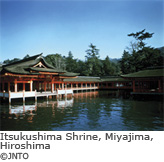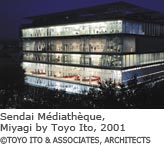 |
 |
 |
 |
|
Traditional Japanese architecture is characterized by wooden single-storey structures. Lacking a
tradition of cave dwellings and stone walls, it was natural for the nation to develop this style. The
traditional structure has not changed during recorded history, remaining intact after Buddhist
architecture entered Japan from China and the Korean Peninsula in the mid-6th century. Even shrine architecture - widely regarded as having been stimulated by Buddhist architecture - retains
the typical wooden single-storey structure.
Wooden construction basically combines posts and beams. If a large building is involved, the
structure spreads on its horizontal axis by joining single-storey rooms. Although a massive structure
is typically dark inside and is thus not always suited to some human activities, Japanese architectural methods cleverly allow light and breeze to penetrate: by opening to the outside, they link a building's interior with its garden.
|

|
|
Japanese architecture is also characterised by large, imposing roofs. This is because a Japanese
building's horizontal axis and low profile make the roof the only indicator of its presence. Although
crowning imposing buildings with suitably impressive roofs is widespread across Asia, the trend
developed in Japan not because of climate (high temperatures and humidity) but to represent a
building's existence symbolically.
Japanese dwellings were basically single-storey until the mid-19th century, when the influence
of Western architecture saw Japanese start to live in two-storey and taller houses. This change also
spurred architects to emphasize facades. The modern architectural movement in early-20th century Europe turned a new spotlight on Japanese architecture and its horizontal focus. European
architecture had traditionally stressed the vertical axis through facades, but modernism marked the
beginning of a twin vertical/horizontal development. Japan's horizontal axis was an awakening for the West.
The world thus rediscovered traditional Japanese architecture and its horizontal axis. One of the
20th century's most significant architects, Kenzo Tange (1913-2005), combined traditional Japanese
architecture with modernism, using a traditional composition of columns and beams as if creating
an abstract painting. His designs brought Japanese architecture's aversion to room divisions directly into modern architecture. Successors such as Fumihiko Maki, Arata Isozaki, Kisho Kurokawa and Yoshio Taniguchi designed buildings using horizontal and vertical axes as simple geometrical structural elements, thus fusing traditional Japanese with modern architecture. Today the succeeding generation of Toyo Ito and Tadao Ando continues to take Japanese architecture in new directions.
|
| |
|
Text by Hiroyuki Suzuki (Professor, History of Architecture, University of Tokyo)
Copyright 2007 - Ministry of Foreign Affairs, Japan |



